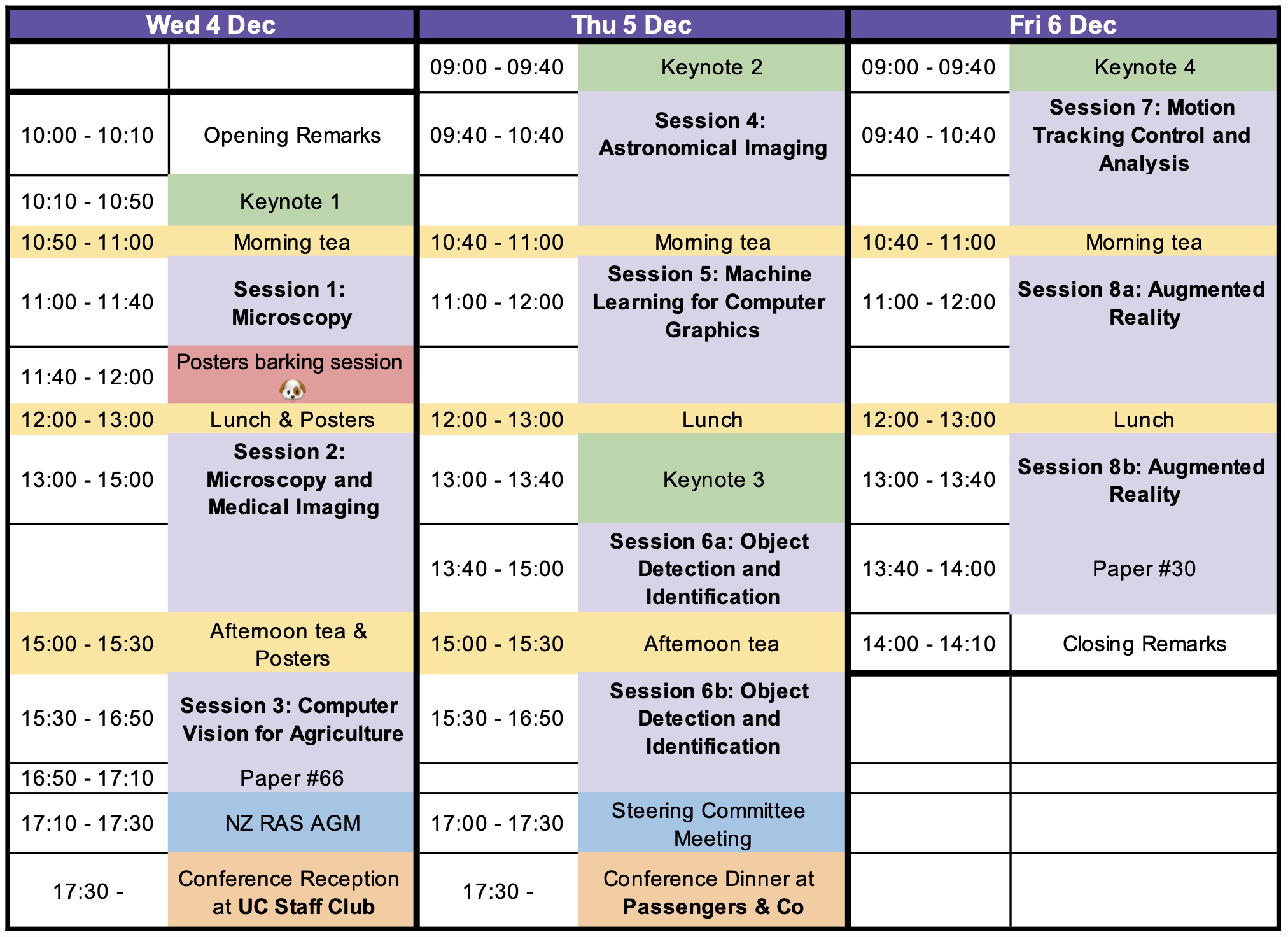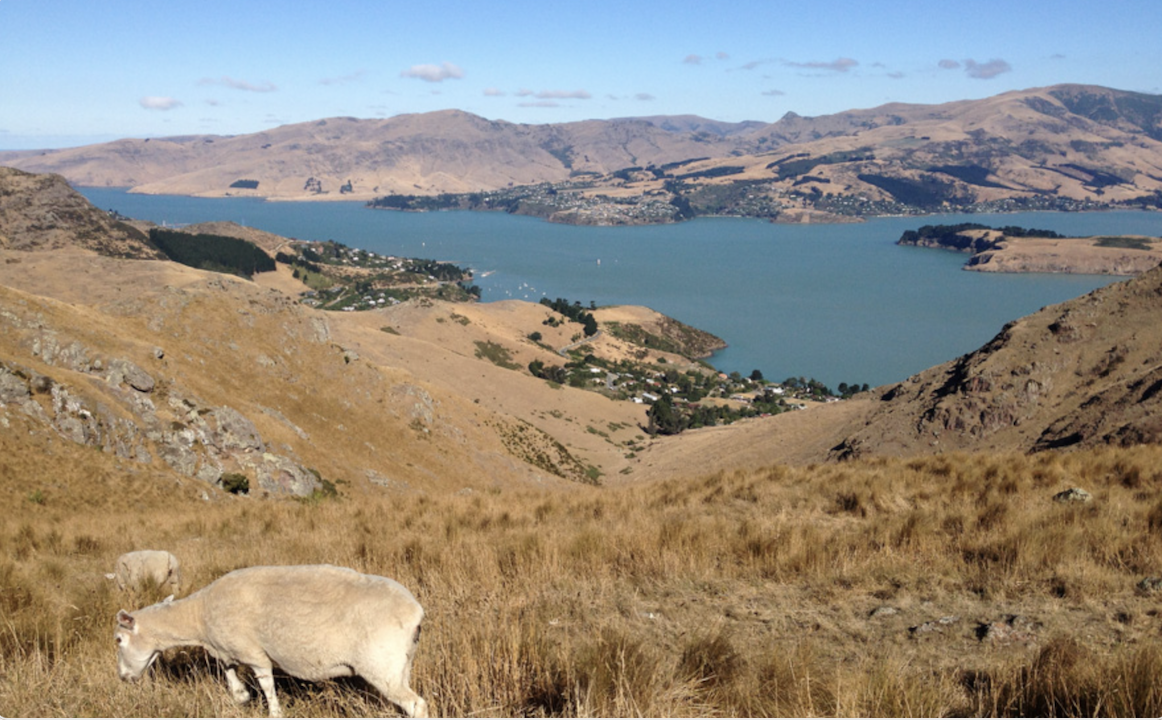- The conference is taking place in John Britten 102 Conference Foyer. The John Britten building is at 69 Creyke Road.
- The Zoom link for virtual attendees has been emailed to all authors.
- Please let Richard or Joe know if you do not have access.
The format for oral presentations is:
15 minutes talk
3 minutes questions
2 minutes for changeover

Key Notes
Keynote 1: Jeff Donatelli
Multi-Tiered Iterative Projection Algorithms for Exploiting Mathematical Structure in Complex Inverse Problems
New experimental technologies have the potential to capture information from important biological objects and new materials at unprecedented detail and scales. However, the accelerating size, rate, complexity, and sensitivity of these new measurements are far outpacing the capability of traditional inversion methods to efficiently and robustly reconstruct the desired information from the data.
In this talk, I will present a new general mathematical framework capable of overcoming many of these emerging challenges in solving complex inverse problems from experimental data. This framework, called Multi-Tiered Iterative Projections (M-TIP), is based on exploiting the mathematical structure of the inverse problem via an iterative application of projection operators that directly target the specific physics of the experiment to maximize speed, accuracy, and robustness. I will demonstrate the use of M-TIP in solving important open problems in inversion for fluctuation X-ray scattering, coherent surface scattering imaging, physics-informed data reduction, and more.
Keynote 2: Julian Maclaren
NZ’s Productivity Challenge: Can Computer Vision and Machine Learning Startups Help Solve the Problem?
Over the last 50 years, New Zealand’s productivity has declined substantially relative to other OECD countries. Tech startups are a promising path to providing new exports that do not compete for land with our primary industries and can generate high paying jobs right here in NZ. This is particularly true in areas like computer vision and AI, where the potential for scalable products with global impact is immense. However, NZ’s startup ecosystem is still developing, and the idea of founding a company is simply not on the radar of most researchers here.
In this talk, I aim to demystify the startup journey, offering suggestions and possibly some inspiration for academics who would like to see their research end up in products. I’ll share my personal experiences gained by founding several computer vision and ML startups, both from overseas and from NZ, as well as from within and from outside academia. I will touch on topics such as patents and IP, forming teams, and venture capital. I hope that attending this talk will make you a little more likely to consider launching a startup and more aware of the opportunities and challenges that await those who take the leap.
Keynote 3: Andrew Lensen
AI for Good: Kākā Conservation and Milk Analysis
Computer vision holds significant promise for addressing real-world challenges, but translating this potential into tangible outcomes requires a strongly interdisciplinary approach. In this keynote, I will share early-stage findings from two of our applied AI research projects that aim to address pressing issues in conservation and milk quality assurance.
The first project, Recognising Taonga with AI, recently funded by an MBIE Smart Ideas grant, weaves together research in AI, ecology, and mātauranga Māori. It aims to develop unsupervised machine learning methods for non-invasive identification of individual kākā in urban environments. It also aligns conservation efforts with indigenous perspectives and expands ecological understanding of kākā behaviour and movements.
The second project applies machine learning to analyse the evaporation dynamics of milk droplets, offering a low-cost, interpretable method for classifying milk composition and detecting adulterants. This work is particularly relevant for improving food safety and quality assurance in resource-limited settings, with the potential for long-term applications in developing regions to enhance public health and food security.
Keynote 4: Mengjie Zhang
Evolutionary Machine Learning and Applications
Since the 1990s, evolutionary computation techniques have been widely used to solve machine learning tasks. In this talk, I will firstly provide a brief overview of machine learning and evolutionary computation, then provide a narrow view and a broad view of evolutionary machine learning. After discussing the state-of-the-art research and applications of the main paradigms of evolutionary machine learning and their success in classification, feature selection, regression, clustering, computer vision and image analysis, I will discuss evolutionary deep learning for image classification and detection with the main challenges.
Oral Presentations
(v) = virtual, (p) = in-person
Session 1: Microscopy (chair: Joe Chen)
| 95 (p) | End-to-end Training of Latent Space Diffusion Models for Conformational Heterogeneity in Cryo-EM Reconstruction | Zixi Hu and Kanupriya Pande |
| 29 (v) | Disentanglement-based Unsupervised Domain Adaptation for Nuclei Instance Segmentation | Jieting Long, Dongnan Liu, Zihao Tang and Weidong Cai |
| 71 (p) | Deep Learning Classification of Microsatellite Status in Colorectal Cancer Whole Slide Images | Anu Ahuja, Arthur Morley-Bunker and Ramakrishnan Mukundan |
Session 2: Medical Imaging (chair: Phil Bones)
| 31 (v) | GroupLearning: Label Noise Mitigation through Multi-Expert Collaboration for Medical Image Analysis | Qinyi Cao, Dongnan Liu, Jianan Fan and Weidong Cai |
| 34 (p) | Towards Clinically Oriented Feature Detection for Melanoma: A Deep Learning Approach | Taran Cyriac John, Qurrat Ul Ain, Harith Al-Sahaf and Mengjie Zhang |
| 46 (p) | Medical Image Synthesis using Autoencoder with Vision Transformer | Zakia Zinat Choudhury, Brendan McCane and Sean Coffey |
| 72 (p) | Spectral Neural Attenuation Fields For Cone Beam CT | Aaron Smith, James Atlas, Niels de Ruiter and Mars Collaboration |
| 93 (p) | Measurement of Ocular Torsion Using Feature Matching on the Iris and Sclera | Arthur Bell and Richard Green |
Session 3: Computer Vision for Agriculture (chair: Richard Clare)
| 40 (v) | Deep Learning for Brassica Oleracea Instance Segmentation in UAV Imagery | Jonel Macalisang |
| 53 (v) | AI Framework for Detecting Lordosis-Kyphosis-Scoliosis in Salmon X-Rays | Loc Nguyen, Seumas Walker, Jane Symonds and Binh Nguyen |
| 62 (v) | Genetic Programming-Based Multi-Object Matching for Mussel Floats in Mussel Farm Images | Dylon Zeng, Ying Bi, Ivy Liu, Bing Xue, Ross Vennell and Mengjie Zhang |
| 82 (p) | Leaf or leaves? A data-centric approach looking at ground truth effect on apple disease segmentation | Masoumeh Keshavarzi, Carl Mesarich, Martin Johnson, Gourab Sen Gupta and Donald Bailey |
| 66 (v) | MAC-VTON: Multi-modal Attention Conditioning for Virtual Try-On with Diffusion-Based Inpainting | Sanhita Pathak, Vinay Kaushik and Brejesh Lall |
Session 4: Astronomical Imaging (chair: Joe Chen)
| 8 (v) | Wavefront Estimation from Pyramid Type Wavefront Sensors Using a Convolutional Neural Network | Kylen Patel, Le Yang and Richard Clare |
| 14 (p) | On Feed-Forward Neural-Network-Based Atmospheric Tomography | Daniel Hopkins, Le Yang and Richard Clare |
| 64 (v) | Demystifying Galaxy Classification : An elegant and powerful hybrid approach | Ankita Sarkar, Sarbani Palit and Ujjwal Bhattacharya |
Session 5: Machine Learning for Computer Graphics (chair: Le Yang)
| 21 (p) | Enhancing Visual Focus: Incorporating Attention into Rule-Based Machine Learning | Abubakar Siddique, Muhammad Iqbal and Will N. Browne |
| 33 (v) | ZS-ACL: Light-weight Zero-shot Image Denoising using alpha-Conditional Loss | Shahmir Khan Mohammed and Shakti Singh |
| 87 (v) | Procedurally Generating Large Synthetic Worlds: Chunked Hierarchical Wave Function Collapse | Robert Christie, Brian Kitchen, Wiktor Tumilowicz, Steffan Hooper and Burkhard Wünsche |
| 91(v) | Gaze Estimation via Synthetic Event-Driven Neural Networks | Himanshu Kumar, Naval Kishore Mehta, Sumeet Saurav and Sanjay Singh |
Session 6: Object Detection and Identification (chair: Donald Bailey)
| 18 (v) | Contrastive Learning for Detecting Invasive Aquatic Species: An Analysis of SimCLR and Self-Supervised Methods with Unlabeled Video Data | Sadia Nasrin Tisha and Greg Hamerly |
| 45 (p) | Foreign Object Detection in Aqueous Food Media using Surface Electric Potential and Machine Learning Techniques | Kin Wai Lee, Michael Hayes, Bill Heffernan, Phil Bones and Jaco Fourie |
| 58 (p) | Impact of Object Detector Accuracy on Tracking-By-Detection Methods: A Case Study with Meerkats | Yuxuan Dong, Patrice Delmas and Mitchell Rogers |
| 63 (p) | Deep Learning-Based Depth Map Generation and YOLO-Integrated Distance Estimation for Radiata Pine Branch Detection Using Drone Stereo Vision | Yida Lin, Bing Xue, Mengjie Zhang, Sam Schofield and Richard Green |
| 75 (p) | Vote Based Line Aggregation for Sports Field Registration | Stephen Hallett, Shahrokh Heidari, Mitchell Rogers and Patrice Delmas |
| 79 (p) | Detection of Pinus Radiata Cutpoints Using Neural Medial Axis Skeletonization | Bradley Scott, Sam Schofield and Richard Green |
| 83 (p) | Re-Identification of Individual Kākā: An Explainable DINO-Based Model | Paula Maddigan, Oskar Ehrhardt, Andrew Lensen and Rachael Shaw |
| 84 (v) | Top-Down Target Object Detection Through Context | Ibrahim Rahman, Christopher Hollitt, Mengjie Zhang, Osama Rehman, Aisha Ajmal and Simon Jigwan Park |
Session 7: Motion Tracking Control and Analysis (chair: Michael Hayes)
| 17 (p) | Evaluating your Re-ID Method for Robustness: Consistency, Domain-Shift and Corruption | Jerome Williams, Ben Yip, Tristrom Cooke and Connor Luckett |
| 52 (p) | Robust 360° Visual Tracking with Dynamic Gnomonic Projection | Hao Peng and Fanglue Zhang |
| 59 (p) | Deep Learning-Based Buoyancy Prediction for Intelligent Mussel Farm Monitoring | Carl McMillan, Junhong Zhao, Bing Xue, Ross Vennell and Mengjie Zhang |
| 70 (p) | Causal Behaviour Modelling for Player Action Prediction in Rugby League Using Graph Neural Networks | Jiaxuan Wang, Ruigeng Wang, Gael Gendron, Shahrokh Heidari, David Arturo Soriano Valdez, Gibran Alfonso Zazueta Cruz, Stephen Hallett, Mitchell Rogers, Alexander Woodward, Alfonso Gastelum Strozzi, Riki Mitchell, Mengjie Zhang, Michael Witbrock and Patrice Delmas |
| 73 (v) | AIM-CP: AI-based Multi-Visual Components Analysis for Crowd Dynamics Prediction | Elham Basunduwah, Muhammad Mohzary, Sejun Song and Baekyoung Choi |
Session 8: Augmented Reality (chair: Rick Millane)
| 22 (p) | Accurate 3D Grapevine Structure Extraction from High-Resolution Point Clouds | Harry Dobbs, Casey Peat, Oliver Batchelor, James Atlas and Richard Green |
| 69 (p) | Investigating Feature Clustering for Generalised 3D Point Cloud Part Segmentation | Nirmal Das, Steven Mills, Lech Szymanski, Xinyu Jiang and Tapabrata Chakraborti |
| 67 (p) | Video Quality Metric Compatible With Psnr Considering Recent Knowledge of Peripheral Characteristics of Human Vision | Anastasia Mozhaeva, Igor Vlasuyk, Aleksei Potashnikov, Vladimir Mazin and Lee Streeter |
| 30 (p) | Evaluating Accuracy and Efficiency of Fruit Image Generation Using Generative AI Diffusion Models for Agricultural Robotics | Kun Zhao, Minh Nguyen and Weiqi Yan |
